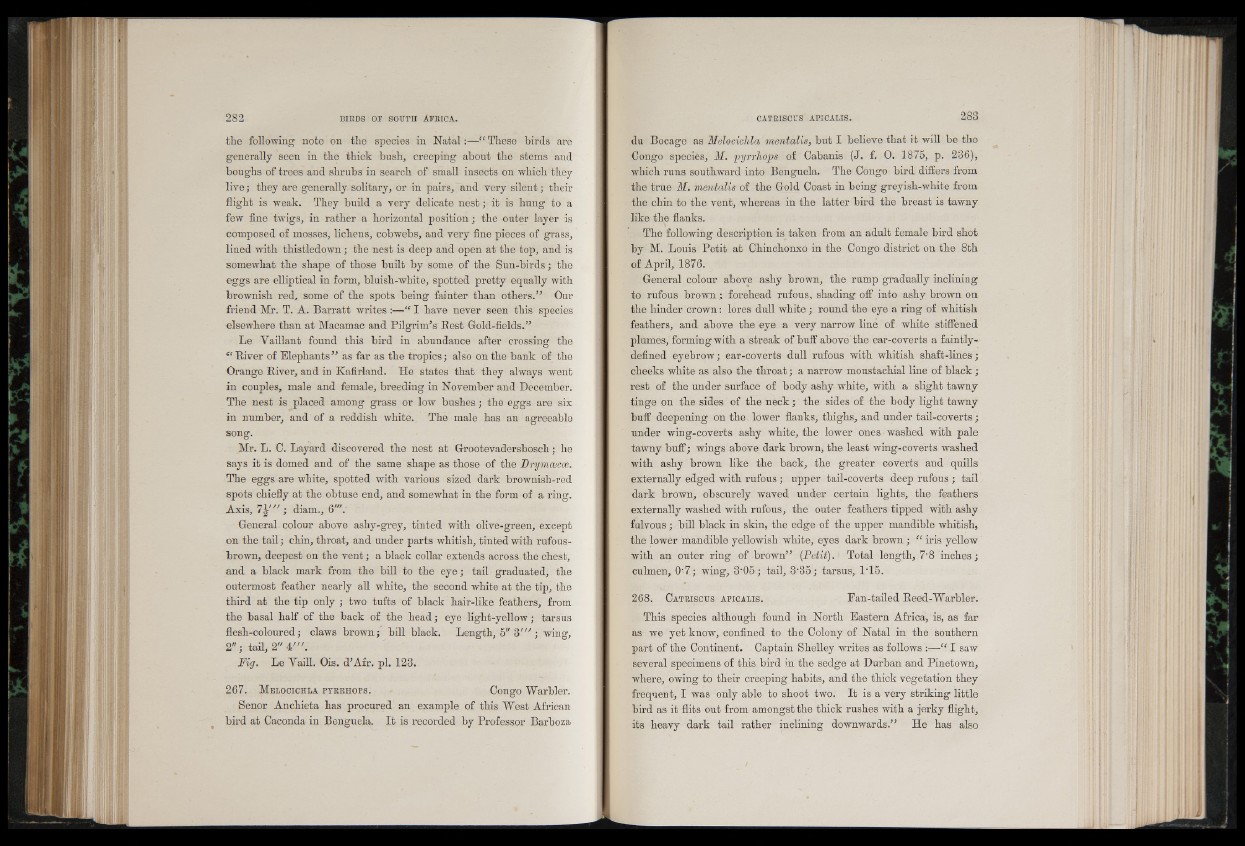
the following note on the species in Natal:—“ These birds are
generally seen in the thick bush, creeping about the stems and
boughs of trees and shrubs in search of small insects on which they
live; they are generally solitary, or in pairs, and very silent; their
flight is weak. They bnild a very delicate nest; it is hung to a
few fine twigs, in rather a horizontal position; the outer layer is
composed of mosses, lichens, cobwebs, and very fine pieces of grass,
lined with thistledown; the nest is deep and open at the top, and is
somewhat the shape of those built by some of the Sun-birds; the
eggs are elliptical in form, bluish-white, spotted pretty equally with
brownish red, some of the spots being fainter than others.” Our
friend Mr. T. A. Barratt writes:—“ I have never seen this species
elsewhere than at Macamac and Pilgrim’s Best Gold-fields.”
Le Vaillant found this bird in abundance after crossing the
“ Biver of Elephants” as far as the tropics; also on the bank of the
Orange Biver, and in Kafirland. He states that they always went
in couples, male and female, breeding in November and December.
The nest is placed among grass or low bushes; the eggs are six
in number, and of a reddish white. The male has an agreeable
song.
Mr. L. C. Layard discovered the nest at Grootevadersbosch; he
says it is domed and of the same shape as those of the Drymcecce.
The eggs are white, spotted with various sized dark brownish-red
spots chiefly at the obtuse end, and somewhat in the form of a ring.
Axis, 1 \'" ; diam., 6'" .'
General colour above ashy-grey, tinted with olive-green, except
on the tail; chin, throat, and under parts whitish, tinted with rufous-
brown, deepest on the vent; a black collar extends across the chest,
and a black mark from the bill to the eye; tail graduated, the
outermost feather nearly all white, the second white at the tip, the
third at the tip only ; two tufts of black hair-like feathers, from
the basal half of the back of the head j eye light-yellow; tarsus
flesh-coloured •, claws brown/ bill black. Length, 5" 3n / ; wing,
2"; tail, 2" 4 '".
Fig. Le Vaill. Ois. d’Afr. pi. 123.
267. M e locichla py r r h o p s . - Congo Warbler.
Senor Anchieta has procured an example of this West African
bird at Caconda in Benguela. It is recorded by Professor Barboza
du Bocage as Melocichla mentalis, but I believe that it will be the
Congo species, M. pyrrhops of Cabanis (J. f. 0. 1875, p. 236),
which runs southward into Benguela. The Congo bird differs from
the true M. mentalis of the Gold Coast in being greyish-white from
the chin to the vent, whereas in the latter bird the breast is tawny
like the flanks.
The following description is taken from an adult female bird shot
by M. Louis Petit at Chinchonxo in the Congo district on the 8th
of April, 1876.
General colour above ashy brown, the rump gradually inclining
to rufous brown; forehead rufous, shading off into ashy brown on
the hinder crown: lores dull white ; round the eye a ring of whitish
feathers, and above the eye a very narrow line of white stiffened
plumes, forming with a streak of buff above the ear-coverts a faintly-
defined eyebrow; ear-coverts dull rufous with whitish shaft-lines;
cheeks white as also the throat; a narrow moustachial line of black;
rest of the under surface of body ashy white, with a slight tawny
tinge on the sides of the neck; the sides of the body light tawny
buff deepening on the lower flanks, thighs, and under tail-coverts ;
under wing-coverts ashy white, the lower ones washed with pale
tawny buff; wings above dark brown, the least wing-coverts washed
with ashy brown like the back, the greater coverts and quills
externally edged with rufous ; upper tail-coverts deep rufous ; tail
dark brown, obscurely waved under certain lights, the feathers
externally washed with rufous, the outer feathers tipped with ashy
fulvous ; bill black in skin, the edge of the upper mandible whitish,
the lower mandible yellowish white, eyes dark brown; “ iris yellow
with an outer ring of brown” (Petit). Total length, 7-8 inches;
culmen, 0*7; wing, 3*05; tail, 3*35; tarsus, 1*15.
268. Catr iscus a f ic a l is . Fan-tailed Beed-Warbler.
This species although found in North Eastern Africa, is, as far
as we yet know, confined to the Colony of Natal in the southern
part of the Continent. Captain Shelley writes as follows :—“ I saw
several specimens of this bird in the sedge at Durban and Pinetown,
where, owing to their creeping habits, and the thick vegetation they
frequent, I was only able to shoot two. It is a very striking little
bird as it flits out from amongst the thick rushes with a jerky flight,
its heavy dark tail rather inclining downwards.” He has also